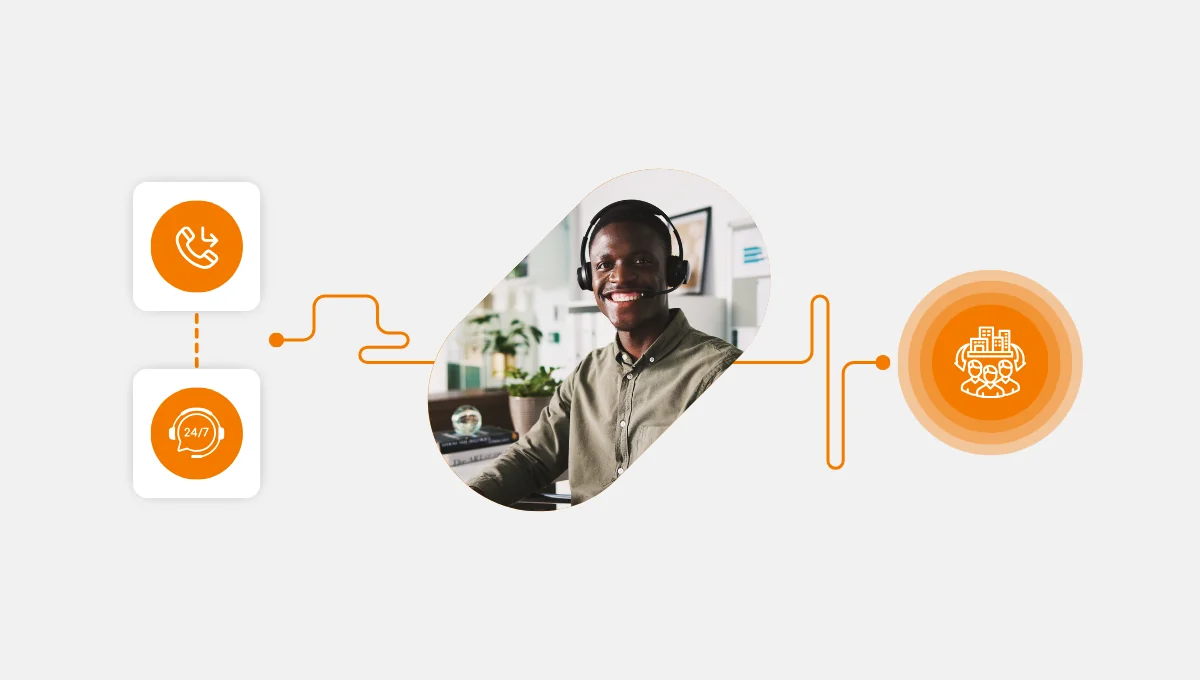In an era defined by heightened environmental awareness, the call center industry stands on the cusp of a profound transformation. What was once a mere afterthought has now become a strategic imperative – sustainability.
As businesses across the globe wholeheartedly embrace eco-friendly practices, our mission is clear: to thoroughly explore this critical paradigm shift.
Uncover the vital role of sustainability and learn how to effectively implement it in your call center operations.
Join us as we embark on a journey to navigate the burgeoning “green revolution” that is reshaping the very landscape of call center practices.
Why is Sustainability Important in Call Centers?
What is the significance of sustainability in call center operations?
Sustainability transcends the “green” label, acting as a catalyst for growth, efficiency, and success within the call center arena.
Let’s explore the pivotal reasons why sustainability matters in this context:
Cost-Efficiency: Sustainable practices, like energy-saving technologies and resource conservation, result in significant cost reductions. These streamlined operations bolster profitability and allocate resources to vital growth initiatives.
Customer Trust and Loyalty: Sustainability resonates with eco-conscious customers. Demonstrating commitment to sustainable practices fosters trust, encourages loyalty, and attracts businesses seeking eco-friendly partnerships.
Corporate Responsibility: Sustainability showcases corporate social responsibility, a prized asset in an era where companies are expected to make positive contributions to society. Embracing sustainability reflects an ethical commitment that resonates with stakeholders.
Competitive Edge: By embracing sustainability, a call center can differentiate itself in a competitive market. It appeals to environmentally conscious clients, forges strategic partnerships, and positions itself as a forward-thinking industry leader.
Reducing Carbon Footprint: Sustainable practices actively reduce the call center’s carbon emissions, aligning with environmental responsibility and enhancing the business’s environmental impact.
These aspects highlight sustainability’s critical role in call centers for both environmental preservation and business success in an evolving landscape.
How do traditional call center practices impact the environment?
These practices contribute to environmental degradation through:
- High Energy Consumption: Traditional call centers often use high amounts of energy for equipment and air conditioning, contributing to increased greenhouse gas emissions.
- Waste Generation: The frequent replacement of outdated equipment results in electronic waste that pollutes landfills and harms the environment.
- Commute Emissions: Employees commuting to centralized call centers add to traffic congestion, carbon emissions, and air pollution.
- Resource Inefficiency: Traditional practices may result in excessive paper usage, which not only harms forests but also contributes to carbon emissions during production.
- Water Consumption: Cooling and HVAC systems in call centers require significant water usage, impacting local water resources.
- Limited Remote Work: The lack of remote work options can lead to underutilized office spaces and unnecessary energy consumption.
The shift towards eco-friendly practices benefits both the planet and your business’s bottom line.
How Can Office Design Promote Sustainability?
What are the key principles of eco-friendly office design?
Creating an eco-friendly office space is an art that combines innovation and environmental responsibility.
The key principles of eco-friendly office design encompass:
- Energy Efficiency: Incorporating efficient lighting, heating, ventilation, and air conditioning systems to minimize energy consumption.
- Natural Lighting: Maximizing natural light sources to reduce reliance on artificial lighting and lower energy use.
- Sustainable Materials: Using eco-friendly materials, such as recycled or reclaimed wood and non-toxic finishes, to minimize environmental impact.
- Indoor Plants: Integrating greenery to improve air quality and enhance the aesthetics of the workspace.
- Waste Reduction: Implementing recycling programs and minimizing single-use plastics to reduce waste generation.
- Flexible Workspaces: Creating adaptable layouts that encourage collaboration, optimize space usage, and accommodate remote work.
- Smart Technology: Employing advanced technology for efficient energy management, lighting control, and HVAC systems.
- Green Certifications: Pursuing green building certifications, like LEED, to validate eco-friendly design choices.
- Biophilic Design: Incorporating nature-inspired elements to enhance well-being and create a calming work environment.
Adhering to these principles in office design not only minimizes environmental impact but also promotes employee well-being, creating a harmonious and sustainable workspace.
How can energy-efficient lighting and HVAC systems contribute to sustainability?
These systems go beyond providing a comfortable working environment, they positively impact both the environment and the financial health of the business.
Reduced energy consumption
Energy-efficient lighting and HVAC systems significantly reduce energy consumption. Through advanced technology and efficient design, these systems reduce electricity consumption, resulting in lower bills and a significant drop in greenhouse gas emissions.
These energy savings align with eco-conscious practices that resonate with customers, investors, and the broader community.
Decreased environmental waste and carbon footprint
The efficiency of these systems extends to the longevity of equipment. Energy-efficient systems are engineered to last longer, reducing the frequency of replacements and the associated environmental waste.
This results in cost savings and a diminished ecological footprint connected to the manufacturing and disposal of hardware.
Increased employee productivity
The well-being of office occupants is greatly influenced by properly functioning HVAC systems. These systems maintain a consistent and comfortable temperature and ensure optimal air quality.
Creating a healthy and enjoyable work environment contributes to increased employee productivity and job satisfaction.
Growing reputation
In addition to practical advantages, adopting energy-efficient technologies can help offices meet sustainability standards and certifications like LEED.
This enhances their environmental reputation and marketability.
Is Going Paperless Feasible for Call Centers?
What steps are involved in transitioning to digital documentation?
Transitioning to digital documentation is a strategic move that enhances efficiency and sustainability. The process involves several key steps, each critical for a seamless transition:
- Step 1: Assessment of Current Practices
Start by evaluating your existing documentation processes to identify areas that you can digitize.
- Step 2: Selecting Digital Tools
Choose the right software and tools tailored to your call center’s specific needs, ensuring they support document creation, storage, and retrieval.
- Step 3: Data Migration
Transfer existing paper or physical documents to digital formats. Scanning, digitization, and data entry may be required.
- Step 4: Digital Document Organization
Implement a structured system for organizing digital documents, including file naming conventions and folder structures.
- Step 5: Security Measures
Prioritize data security by implementing encryption, user access controls, and regular backups to protect sensitive information.
- Step 6: Training and User Adoption
Train your staff on the new digital documentation system to ensure seamless adoption and efficient usage.
- Step 7: Workflow Integration
Integrate digital documentation with your call center’s existing software, optimizing workflow and reducing manual data entry.
- Step 8: Document Version Control
Implement version control to track and manage document revisions accurately.
- Step 9: Compliance and Record Keeping
Ensure that your digital documentation practices comply with legal and regulatory requirements, particularly if your industry has specific mandates.
- Step 10: Monitoring and Improvement
Continuously monitor your digital documentation system’s performance and seek ways to enhance efficiency and user experience.
These steps facilitate a smooth transition to digital documentation in call centers, reducing paper use, streamlining processes, and enhancing operational efficiency.
What are the advantages of electronic record-keeping?
Here are the top five advantages of electronic record-keeping for call centers:
- Efficiency: Electronic record-keeping streamlines data management, eliminating the need for physical storage and manual record retrieval, saving time and resources.
- Cost Savings: Transitioning from paper-based systems reduces costs associated with paper, ink, physical storage, and document transportation, leading to significant financial savings.
- Accessibility: Electronic records are accessible from any location with an internet connection, enabling remote work capabilities and quick access to critical information.
- Security: Robust encryption and access controls ensure data security, protecting sensitive information from unauthorized access and potential breaches.
- Sustainability: By reducing paper consumption, electronic record-keeping supports environmental sustainability, minimizing the ecological impact of paper production and disposal.
These advantages collectively contribute to a more efficient, cost-effective, secure, and sustainable document management system for call centers.
What Are the Options for Using Renewable Energy?
How can call centers incorporate solar or wind energy sources?
Here are the five steps for incorporating solar or wind energy sources into call centers:
- Site Assessment: Evaluate your location’s suitability for solar panels or wind turbines based on available sunlight, wind patterns, and space.
- Energy Audit: Begin with an energy audit to assess your call center’s power consumption and identify opportunities for renewable energy integration.
- Solar Panels: If viable, install photovoltaic panels to harness sunlight for electricity generation.
- Grid Connection: Consider grid-tied systems to feed excess energy back into the grid, potentially earning revenue or credits.
- Monitoring and Maintenance: Regularly monitor and maintain your renewable energy systems to ensure optimal performance and longevity.
These steps are vital for a successful transition to renewable energy in call centers, emphasizing sustainability and efficiency.
What are the environmental benefits of reducing the carbon footprint?
Reducing the carbon footprint presents a myriad of environmental benefits that extend far beyond the realm of call centers.
Foremost, carbon reduction contributes to the global effort to combat climate change. By curbing carbon emissions, we lessen the severity of extreme weather events and reduce the associated damage to communities and ecosystems.
Moreover, a reduced carbon footprint directly improves air quality. Fewer carbon emissions translate into less air pollution.
Reducing carbon emissions also ties into the conservation of natural resources. A lower carbon footprint means a decreased reliance on resource-intensive energy production, preserving vital ecosystems and biodiversity.
As we reduce our carbon emissions, we decrease the stress on our planet’s limited resources.
These advantages underscore the significant role it plays in mitigating environmental challenges and promoting sustainability.
Conclusion
Embrace sustainability today and unlock a brighter future for your call center operations. By transitioning to eco-friendly practices, you not only enhance efficiency but also contribute to a greener world.
Companies with average on-premise to cloud migrations can drive 65% energy reduction and carbon emission reduction of 84%. Cloud technology eliminates the necessity for physical hardware or office spaces, delivering cost-effective advantages and enabling seamless remote work opportunities.
Join the revolution with Call Center Studio, our 100% cloud-based call center software, offering relevant features to support your sustainable journey.
Stay ahead in this eco-conscious era, and make a positive impact with every call.






